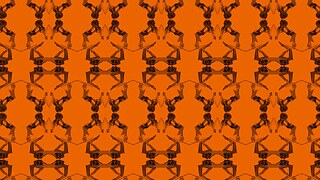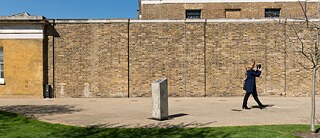Making the invisible visible: Art meets AI
Generally, the works of contemporary artists have been embodied ruminations on AI’s impact on existential questions of the self and our future interaction with nonhuman entities. Few, though, have taken the technologies and innovations of AI as the underlying materials of their work and sculpted them to their own vision.
In the Introduction to the second edition of his book Understanding Media, Marshall McLuhan noted the ability of art to “anticipate future social and technological developments.” Art is “an early alarm system,” pointing us to new developments in times ahead and allowing us “to prepare to cope with them ... Art as a radar environment takes on the function of indispensable perceptual training.”
In 1964, when McLuhan’s book was first published, the artist Nam June Paik was just building his Robot K-456 to experiment with the technologies that subsequently would start to influence society. He had worked with television earlier, challenging its usual passive consuming by the viewer, and later made art with global live-satellite broadcasts, using the new media less for entertainment than to point us to their poetic and intercultural capacities (which are still mostly unused today). The Paiks of our time, of course, are now working with the Internet, digital images, and artificial intelligence. Their works and thoughts again are an early alarm system for the developments ahead of us.
As a curator, my daily work is to bring together different works of art and to connect different cultures. Since the early 1990s, I have also started to organize conversations and meetings with practitioners from different disciplines, in order to go beyond the general reluctance to pooling knowledge. Since I was interested to hear what artists have to say about artificial intelligence, I organized several conversations between artists and engineers.
The reason to look closely at AI is that two of the most important questions of today are “How capable will AI become?” and “What dangers may arise from it?” Its early applications already influence our everyday lives in ways that are more or less recognizable. There is an increasing impact on many aspects of our society, but whether this might be, in general, beneficial or malign is still uncertain.
Many contemporary artists are following these developments closely. They are articulating various doubts about the promises of AI and reminding us not to associate the term “artificial intelligence” solely with positive outcomes. To the current discussions of AI, the artists contribute their specific perspectives and notably their focus on questions of image making, creativity, and the use of programming as artistic tools.
The deep connections between science and art had already been noted by the late Heinz von Foerster, one of the architects of cybernetics, who worked with Norbert Wiener from the mid-1940s and in the 1960s founded the field of second-order cybernetics, in which the observer is understood as part of the system itself and not an external entity. I knew von Foerster well, and in one of our many conversations, he offered his views on the relation between art and science:
When I asked him how he defined cybernetics, von Foerster answered:
Today, where algorithms of AI are applied in daily tasks, one can ask how the human factor is included in these kinds of processes and what role creativity and art could play in relation to them. There are thus different levels to think about when exploring the relation between AI and art.
So, what do contemporary artists have to say about artificial intelligence?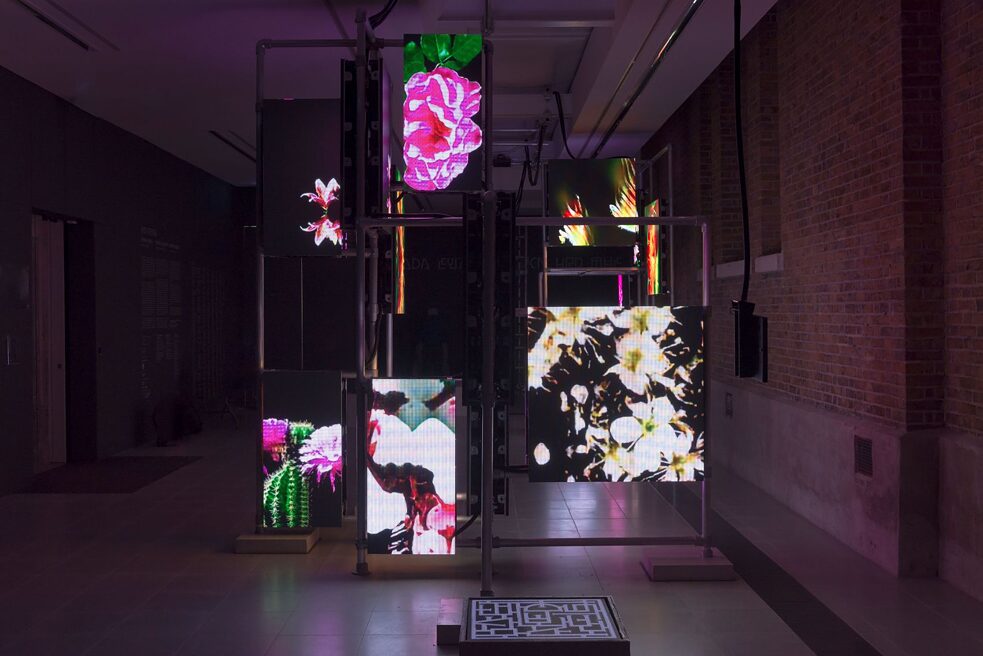 Hito Steyerl's "Power Plants" exhibition at the Serpentine Galleries in 2019
| © Serpentine Galleries
Hito Steyerl's "Power Plants" exhibition at the Serpentine Galleries in 2019
| © Serpentine Galleries
Steyerl has worked with computer technology for many years, and her recent artworks have explored surveillance techniques, robots, and such computer games as in How Not to Be Seen (2013), on digital-image technologies, or HellYeahWeFuckDie (2017), about the training of robots in the still difficult task of keeping balance. But to explain her notion of artificial stupidity, Steyerl refers to a more general phenomenon, like the now widespread use of Twitter bots, noting in our conversation:
As has been widely noted, this kind of technology was seen in the many automated Twitter posts before the 2016 US presidential election and also shortly before the Brexit vote. If even low-grade AI technology like these bots are already influencing our politics, this raises another urgent question: “How powerful will far more advanced techniques be in the future?”
What she seeks is a more profound understanding of computer-generated images and the different aesthetic forms they use. They are obviously not generated with the explicit goal of following a certain aesthetic tradition. The computer engineer Mike Tyka, in a conversation with Steyerl, explained the functions of these images:
Nevertheless, these images have aesthetic implications and values which have to be taken into account. One could say that while the programmers use these images to help us better understand the programs’ algorithms, we need the knowledge of artists to better understand the aesthetic forms of AI. As Steyerl has pointed out, such visualizations are generally understood as “true” representations of processes, but we should pay attention to their respective aesthetics, and their implications, which have to be viewed in a critical and analytical way.
In 2017, the artist Trevor Paglen created a project to make these invisible AI algorithms visible. In Sight Machine, he filmed a live performance of the Kronos Quartet and processed the resulting images with various computer software programs used for face detection, object identification, and even for missile guidance. He projected the outcome of these algorithms, in real time, back to screens above the stage. By demonstrating how the various different programs interpreted the musicians’ performance, Paglen showed that AI algorithms are always determined by sets of values and interests which they then manifest and reiterate, and thus must be critically questioned. The significant contrast between algorithms and music also raises the issue of relationships between technical and human perception.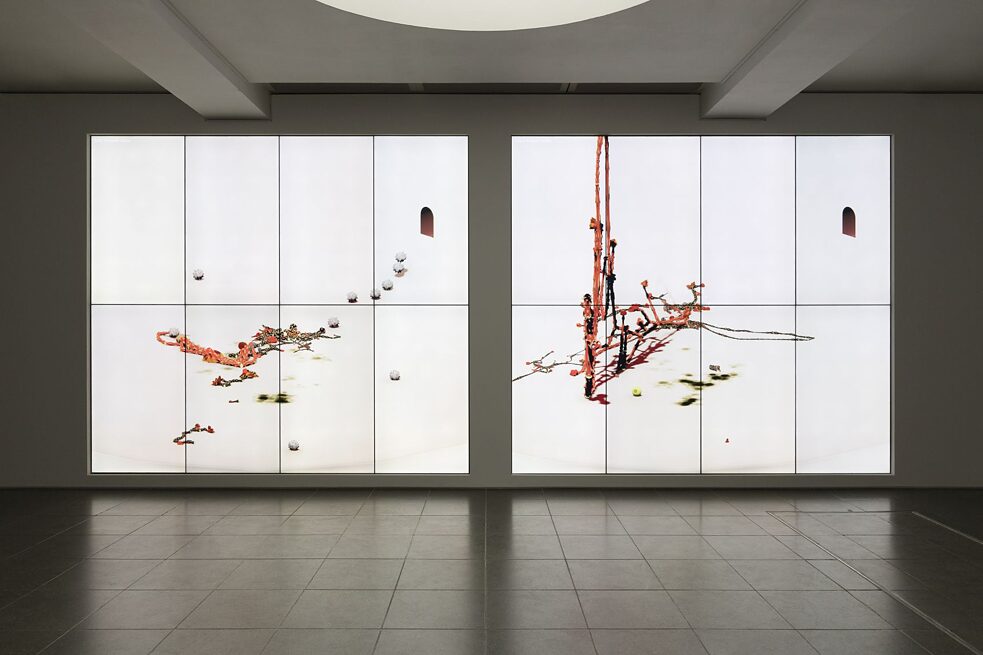 Ian Cheng's "BOB (Bag of Beliefs)", artificial lifeform, 2018-2019
| Courtesy: the artist, Gladstone Gallery, Pilar Corrias Gallery
Ian Cheng's "BOB (Bag of Beliefs)", artificial lifeform, 2018-2019
| Courtesy: the artist, Gladstone Gallery, Pilar Corrias Gallery
This last point underlines the fundamental difference between any human artistic production and so-called computer creativity. Rose sees AI more as a possible way to create better tools for humans:
“A place I can imagine machine learning working for an artist would be not in developing an independent subjectivity, like writing a poem or making an image, but actually in filling in gaps that are to do with labor, like the way that Photoshop works with different tools that you can use.”
And though such tools may not seem spectacular, she says, “they might have a larger influence on art,” because they provide artists with further possibilities in their creative work.
Kenric McDowell, in our conversation with Rachel Rose, added that he, too, believes that there are false expectations around AI. “I’ve observed,” he said, “that there’s a sort of magical quality to the idea of a computer that does all the things that we do.” He continued: “There’s almost this kind of demonic mirror that we look into, and we want it to write a novel, we want it to make a film, we want to give that away somehow.” He is instead working on projects wherein humans are collaborating with the machine. One of the current aims of AI research is to find new means of interaction between humans and software. And art, one could say, needs to play a key role in that enterprise, since it focuses on our subjectivity and on essential human aspects like empathy and mortality.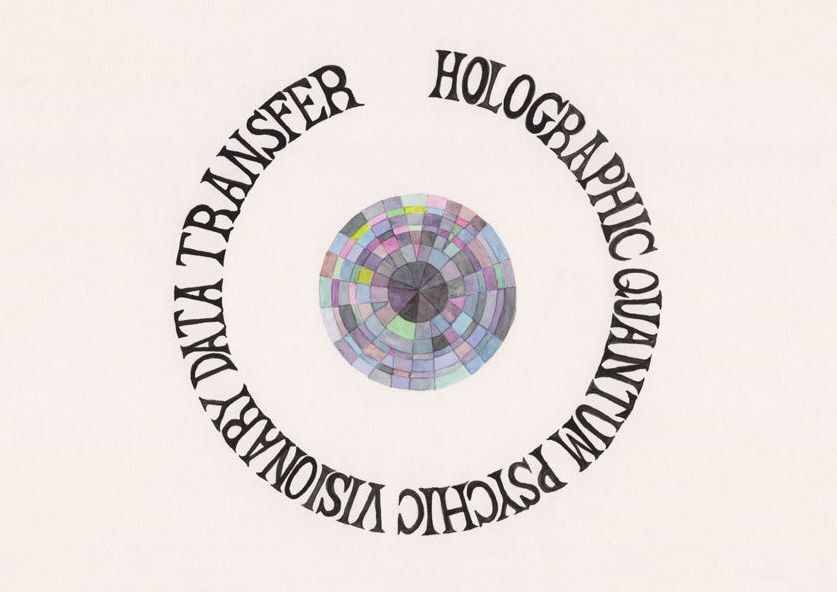 Suzanne Treister's "The Escapist BHST/Desktop Portal/Holographic Quantum Psychic Visionary Data Transfer", 2019
| Courtesy: the artist, Annely Juda Fine Art, London and P.P.O.W. Gallery, New York
Suzanne Treister's "The Escapist BHST/Desktop Portal/Holographic Quantum Psychic Visionary Data Transfer", 2019
| Courtesy: the artist, Annely Juda Fine Art, London and P.P.O.W. Gallery, New York
In her project, she created thirty photo-text works about the conference attendees, which included Wiener and von Foerster; she invented tarot cards; and she made a video based on a photomontage of a “cybernetic séance,” in which the conference participants are seen sitting at a round table as if in a spiritualistic séance, while certain of their statements on cybernetics are heard in an audio-collage. Thus she combined rational knowledge and superstition. She also pointed out that some of the participating scientists in fact worked for the military, thus the application of cybernetics could be seen in an ambivalent way, even back then, as a tussle between pure knowledge and its use in state control.
If one looks at Treister’s work about the Macy conference participants, one sees that no visual artist was included. A dialogue between artists and scientists would be fruitful in future discussions, and it is a bit astonishing that this wasn’t realized at the time, given von Foerster’s keen interest in art. He recounted in one of our conversations how his relation to the field dates back to his childhood:
Though for von Foerster the relation between the art and science was always clear, for our own time this connection remains to be made. There are many reasons to multiply the links. The critical thinking of artists would be beneficial in respect to the dangers of AI, as they draw our attention to the questions they consider essential from their perspective. With the advent of machine learning, new tools are available to artists for their work. And as the algorithms of AI are made visible through artificial images in new ways, artists’ critical visual knowledge and expertise will be harnessed. As many of the key questions of AI are philosophical in nature and can only be answered from a holistic point of view, the way they play out among adventurous artists will be worth following.
While the majority of artistic works that utilize recent developments in AI specifically draw from the field of machine learning, Cheng’s Live Simulations take a separate route. The protagonists and plot lines that are interlaced in each episodic simulation of Emissaries use the complex logic systems and rules of AI. What is profound about his continually evolving scenes is that complexity arises not through the desire/actions of any single actor or artificial godhead but instead through their constellation, collision, and constant evolution in symbiosis with one another. This gives rise to unexpected outcomes and unending, unknowable situations—you can never experience the exact same moment in successive viewings of his work.
Cheng had a discussion at the Serpentine Marathon Guest, Ghost, Host: Machine! with the programmer Richard Evans, who recently designed Versu, an AI-based platform for interactive storytelling games. Evans’ work emphasizes the social interaction of the games’ characters, who react in a spectrum of possible behaviors to the choices made by the human players. In their conversation, Evans said that a starting point for the project was that most earlier simulation video games, such as The Sims, did not sufficiently take into account the importance of social practices. Simulated protagonists in games would often act in ways that did not correspond well with real human behavior. Knowledge of social practices limits the possibilities of action but is necessary to understand the meaning of our actions. This is what interests Cheng for his own simulations. The more parameters of actions in certain circumstances are determined in a computer simulation, the more interesting it is for Cheng to experiment with individual and specific changes. He told Evans, “I gather that if we had AI with more ability to respond to social contexts, tweaking one thing, you would get something quite artistic and beautiful.”
Cheng also sees the work of programmers and AI simulations as creating new and sophisticated tools for experimenting with the parameters of our daily social practices. In this way, the involvement of artists in AI will lead to new kinds of open experiments in Art. Such possibilities are—like increased AI capabilities in general—still in the future. Recognizing that this is an experimental technology in its infancy, very far from apocalyptic visions of a superintelligent AI takeover, Cheng fills his simulations with prosaic avatars such as strange microbial globules, dogs, and the undead.
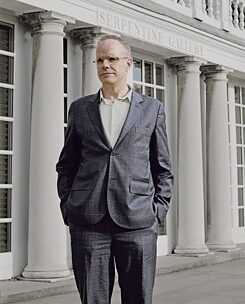 Hans Ulrich Obrist
| © Andreas Schmidt
Discussions like these, between artists and engineers, of course are not totally new. In the 1960s, the engineer Billy Klüver brought artists together with engineers in a series of events, and in 1967 he founded the Experiments in Art and Technology program with Robert Rauschenberg and others. In London, at around the same time, Barbara Stevini and John Latham, of the Artist Placement Group, took things a step further by asserting that there should be artists in residence in every company and every government. Today, these inspiring historical models can be applied to the field of AI. As AI comes to inhabit more and more of our everyday lives, the creation of a space that is nondeterministic and nonutilitarian in its plurality of perspectives and diversity of understandings will undoubtedly be essential.
Hans Ulrich Obrist
| © Andreas Schmidt
Discussions like these, between artists and engineers, of course are not totally new. In the 1960s, the engineer Billy Klüver brought artists together with engineers in a series of events, and in 1967 he founded the Experiments in Art and Technology program with Robert Rauschenberg and others. In London, at around the same time, Barbara Stevini and John Latham, of the Artist Placement Group, took things a step further by asserting that there should be artists in residence in every company and every government. Today, these inspiring historical models can be applied to the field of AI. As AI comes to inhabit more and more of our everyday lives, the creation of a space that is nondeterministic and nonutilitarian in its plurality of perspectives and diversity of understandings will undoubtedly be essential.
The above essay was first published as part of the lecture New Experiments in Art and Technology at the Saas Fee Academy in 2018 and is reprinted here with permission of the author and with the kind support of the Swiss Consulate General in Sydney.
Learn more about Hans Ulrich Obrist's views on the future of creative AI here.
In 1964, when McLuhan’s book was first published, the artist Nam June Paik was just building his Robot K-456 to experiment with the technologies that subsequently would start to influence society. He had worked with television earlier, challenging its usual passive consuming by the viewer, and later made art with global live-satellite broadcasts, using the new media less for entertainment than to point us to their poetic and intercultural capacities (which are still mostly unused today). The Paiks of our time, of course, are now working with the Internet, digital images, and artificial intelligence. Their works and thoughts again are an early alarm system for the developments ahead of us.
As a curator, my daily work is to bring together different works of art and to connect different cultures. Since the early 1990s, I have also started to organize conversations and meetings with practitioners from different disciplines, in order to go beyond the general reluctance to pooling knowledge. Since I was interested to hear what artists have to say about artificial intelligence, I organized several conversations between artists and engineers.
The reason to look closely at AI is that two of the most important questions of today are “How capable will AI become?” and “What dangers may arise from it?” Its early applications already influence our everyday lives in ways that are more or less recognizable. There is an increasing impact on many aspects of our society, but whether this might be, in general, beneficial or malign is still uncertain.
Many contemporary artists are following these developments closely. They are articulating various doubts about the promises of AI and reminding us not to associate the term “artificial intelligence” solely with positive outcomes. To the current discussions of AI, the artists contribute their specific perspectives and notably their focus on questions of image making, creativity, and the use of programming as artistic tools.
The deep connections between science and art had already been noted by the late Heinz von Foerster, one of the architects of cybernetics, who worked with Norbert Wiener from the mid-1940s and in the 1960s founded the field of second-order cybernetics, in which the observer is understood as part of the system itself and not an external entity. I knew von Foerster well, and in one of our many conversations, he offered his views on the relation between art and science:
“I’ve always perceived art and science as complementary fields. One shouldn’t forget that a scientist is in some respects also an artist. He invents a new technique and he describes it. He uses language like a poet, or the author of a detective novel, and describes his findings. In my view, a scientist must work in an artistic way if he wants to communicate his research. He obviously wants to communicate and talk to others. A scientist invents new objects, and the question is, how to describe them. In all of these aspects, science is not very different from art.”
When I asked him how he defined cybernetics, von Foerster answered:
“The substance of what we have learned from cybernetics is to think in circles: A leads B, B to C, but C can return to A. Such kinds of arguments are not linear but circular. The significant contribution of cybernetics to our thinking is to accept circular arguments. This means that we have to look at circular processes and understand, under which circumstances an equilibrium and thus a stable structure emerges.”
Today, where algorithms of AI are applied in daily tasks, one can ask how the human factor is included in these kinds of processes and what role creativity and art could play in relation to them. There are thus different levels to think about when exploring the relation between AI and art.
So, what do contemporary artists have to say about artificial intelligence?
 Hito Steyerl's "Power Plants" exhibition at the Serpentine Galleries in 2019
| © Serpentine Galleries
Hito Steyerl's "Power Plants" exhibition at the Serpentine Galleries in 2019
| © Serpentine Galleries
Artificial stupidity
Hito Steyerl, an artist who works with documentary and experimental film, considers two key aspects that we should keep in mind when reflecting on the implications of AI for society. First, the expectations for so-called artificial intelligence, she says, are often overrated and the noun “intelligence” is misleading—to counter that, she uses the term “artificial stupidity.” Second, she points out that programmers are now making invisible software algorithms visible through images, but to understand and interpret these images better, we should apply the expertise of artists.Steyerl has worked with computer technology for many years, and her recent artworks have explored surveillance techniques, robots, and such computer games as in How Not to Be Seen (2013), on digital-image technologies, or HellYeahWeFuckDie (2017), about the training of robots in the still difficult task of keeping balance. But to explain her notion of artificial stupidity, Steyerl refers to a more general phenomenon, like the now widespread use of Twitter bots, noting in our conversation:
“It was and still is a very popular tool in elections to deploy Twitter armies to sway public opinion and deflect popular hashtags and so on. This is an artificial intelligence of a very, very low grade. It’s two or maybe three lines of script. It’s nothing very sophisticated at all. Yet the social implications of this kind of artificial stupidity, as I call it, are already monumental in global politics.”
As has been widely noted, this kind of technology was seen in the many automated Twitter posts before the 2016 US presidential election and also shortly before the Brexit vote. If even low-grade AI technology like these bots are already influencing our politics, this raises another urgent question: “How powerful will far more advanced techniques be in the future?”
Visible / Invisible
The artist Paul Klee often talked about art as “making the invisible visible.” In computer technology, most algorithms work invisibly, in the background; they remain inaccessible in the systems we use daily. But lately there has been an interesting comeback of visuality in machine learning. The ways that the deep-learning algorithms of AI are processing data have been made visible through applications like Google’s DeepDream, in which the process of computerized pattern-recognition is visualized in real time. The application shows how the algorithm tries to match animal forms with any given input. There are many other AI visualization programs that, in their way, also “make the invisible visible.” The difficulty in the general public’s perception of such images is, in Steyerl’s view, that these visual patterns are viewed uncritically as realistic and objective representation of the machine process. She says of the aesthetics of such visualizations:“For me, this proves that science has become a subgenre of art history ... We now have lots of abstract computer patterns that might look like a Paul Klee painting, or a Mark Rothko, or all sorts of other abstractions that we know from art history. The only difference, I think, is that in current scientific thought they’re perceived as representations of reality, almost like documentary images, whereas in art history there’s a very nuanced understanding of different kinds of abstraction.”
What she seeks is a more profound understanding of computer-generated images and the different aesthetic forms they use. They are obviously not generated with the explicit goal of following a certain aesthetic tradition. The computer engineer Mike Tyka, in a conversation with Steyerl, explained the functions of these images:
“Deep-learning systems, especially the visual ones, are really inspired by the need to know what’s going on in the black box. Their goal is to project these processes back into the real world.”
Nevertheless, these images have aesthetic implications and values which have to be taken into account. One could say that while the programmers use these images to help us better understand the programs’ algorithms, we need the knowledge of artists to better understand the aesthetic forms of AI. As Steyerl has pointed out, such visualizations are generally understood as “true” representations of processes, but we should pay attention to their respective aesthetics, and their implications, which have to be viewed in a critical and analytical way.
In 2017, the artist Trevor Paglen created a project to make these invisible AI algorithms visible. In Sight Machine, he filmed a live performance of the Kronos Quartet and processed the resulting images with various computer software programs used for face detection, object identification, and even for missile guidance. He projected the outcome of these algorithms, in real time, back to screens above the stage. By demonstrating how the various different programs interpreted the musicians’ performance, Paglen showed that AI algorithms are always determined by sets of values and interests which they then manifest and reiterate, and thus must be critically questioned. The significant contrast between algorithms and music also raises the issue of relationships between technical and human perception.
 Ian Cheng's "BOB (Bag of Beliefs)", artificial lifeform, 2018-2019
| Courtesy: the artist, Gladstone Gallery, Pilar Corrias Gallery
Ian Cheng's "BOB (Bag of Beliefs)", artificial lifeform, 2018-2019
| Courtesy: the artist, Gladstone Gallery, Pilar Corrias Gallery
Computers, as a tool for creativity, can't replace the artist
Rachel Rose, a video artist who thinks about the questions posed by AI, employs computer technology in the creation of her works. Her films create for the viewer an experience of materiality through the moving image. She uses collaging and layering of the material to manipulate sound and image, and the editing process is perhaps the most important aspect of her work. She also talks about the importance of decision making in her work. For her, the artistic process does not follow a rational pattern. She explained this in a conversation we had together with the engineer Kenric McDowell at the Google Cultural Institute by means of a story from theatre director Peter Brook’s 1968 book The Empty Space. When Brook designed the set for his production of The Tempest in the late 1960s, he started by making a Japanese garden, but then the design evolved, becoming a white box, a black box, a realistic set, and so on. And in the end, he returned to his original idea. Brook writes that he was shocked by spending a month on his labors, only to end at the beginning. But this shows that the creative artistic process is a succession whose each step builds on the next and in the end comes to a conclusion that is unpredictable. The process is not a logical or rational succession but has mostly to do with the artist’s feelings in reaction to the preceding result. Rose said, of her own artistic decision making:“It to me is distinctively different from machine learning, because at each decision there’s this core feeling that comes from a human being which has to do with empathy, which has to do with communication, which has to do with questions about our own mortality that only a human could ask.”
This last point underlines the fundamental difference between any human artistic production and so-called computer creativity. Rose sees AI more as a possible way to create better tools for humans:
“A place I can imagine machine learning working for an artist would be not in developing an independent subjectivity, like writing a poem or making an image, but actually in filling in gaps that are to do with labor, like the way that Photoshop works with different tools that you can use.”
And though such tools may not seem spectacular, she says, “they might have a larger influence on art,” because they provide artists with further possibilities in their creative work.
Kenric McDowell, in our conversation with Rachel Rose, added that he, too, believes that there are false expectations around AI. “I’ve observed,” he said, “that there’s a sort of magical quality to the idea of a computer that does all the things that we do.” He continued: “There’s almost this kind of demonic mirror that we look into, and we want it to write a novel, we want it to make a film, we want to give that away somehow.” He is instead working on projects wherein humans are collaborating with the machine. One of the current aims of AI research is to find new means of interaction between humans and software. And art, one could say, needs to play a key role in that enterprise, since it focuses on our subjectivity and on essential human aspects like empathy and mortality.
 Suzanne Treister's "The Escapist BHST/Desktop Portal/Holographic Quantum Psychic Visionary Data Transfer", 2019
| Courtesy: the artist, Annely Juda Fine Art, London and P.P.O.W. Gallery, New York
Suzanne Treister's "The Escapist BHST/Desktop Portal/Holographic Quantum Psychic Visionary Data Transfer", 2019
| Courtesy: the artist, Annely Juda Fine Art, London and P.P.O.W. Gallery, New York
Cybernetics / Art
Suzanne Treister is an artist whose work from 2009 to 2011 serves as an example of what is happening at the intersection of our current technologies, the arts, and cybernetics. Treister has been a pioneer in digital art since the 1990s, inventing, for example, imaginary video games and painting “screenshots” from them. In her project Hexen 2.0 she looked back at the famous Macy conferences on cybernetics that between 1946 and 1953 were organized in New York by engineers and social scientists to unite the sciences and to develop a universal theory of the workings of the mind.In her project, she created thirty photo-text works about the conference attendees, which included Wiener and von Foerster; she invented tarot cards; and she made a video based on a photomontage of a “cybernetic séance,” in which the conference participants are seen sitting at a round table as if in a spiritualistic séance, while certain of their statements on cybernetics are heard in an audio-collage. Thus she combined rational knowledge and superstition. She also pointed out that some of the participating scientists in fact worked for the military, thus the application of cybernetics could be seen in an ambivalent way, even back then, as a tussle between pure knowledge and its use in state control.
If one looks at Treister’s work about the Macy conference participants, one sees that no visual artist was included. A dialogue between artists and scientists would be fruitful in future discussions, and it is a bit astonishing that this wasn’t realized at the time, given von Foerster’s keen interest in art. He recounted in one of our conversations how his relation to the field dates back to his childhood:
“I grew up as a child in an artistic family. We often had visits from poets, philosophers, painters and sculptors. Art was a part of my life. Later, I got into physics, as I was talented in this subject. But I always remained conscious of the importance of art for science. There wasn’t a great difference for me. For me, both aspects of life have always been very much alike, and accessible too. We should see them as one. An artist also has to reflect on his work. He has to think about his grammar and his language. A painter must know how to handle his colors. Just think of how intensively oil colors were researched during the Renaissance. They wanted to know how a certain pigment could be mixed with others to get a certain tone of red or blue. Chemists and painters collaborated very closely. I think the artificial division between science and art is wrong.”
Though for von Foerster the relation between the art and science was always clear, for our own time this connection remains to be made. There are many reasons to multiply the links. The critical thinking of artists would be beneficial in respect to the dangers of AI, as they draw our attention to the questions they consider essential from their perspective. With the advent of machine learning, new tools are available to artists for their work. And as the algorithms of AI are made visible through artificial images in new ways, artists’ critical visual knowledge and expertise will be harnessed. As many of the key questions of AI are philosophical in nature and can only be answered from a holistic point of view, the way they play out among adventurous artists will be worth following.
Simulating worlds
For the most part, the works of contemporary artists have been embodied ruminations on AI’s impact on existential questions of the self and our future interaction with nonhuman entities. Few, though, have taken the technologies and innovations of AI as the underlying materials of their work and sculpted them to their own vision. An exception is the artist Ian Cheng, who has gone as far as to construct entire worlds of artificial beings with varying degrees of sentience and intelligence. He refers to these worlds as Live Simulations. His Emissaries trilogy (2015-2017) is set in a fictional postapocalyptic world of flora and fauna, in which AI-driven animals and creatures explore the landscape and interact with each other. Cheng uses advanced graphics but has them programmed with a lot of glitches and imperfections, which imparts a futuristic and anachronistic atmosphere at the same time. Through his trilogy, which charts a history of consciousness, he asks the question “What is a simulation?”While the majority of artistic works that utilize recent developments in AI specifically draw from the field of machine learning, Cheng’s Live Simulations take a separate route. The protagonists and plot lines that are interlaced in each episodic simulation of Emissaries use the complex logic systems and rules of AI. What is profound about his continually evolving scenes is that complexity arises not through the desire/actions of any single actor or artificial godhead but instead through their constellation, collision, and constant evolution in symbiosis with one another. This gives rise to unexpected outcomes and unending, unknowable situations—you can never experience the exact same moment in successive viewings of his work.
Cheng had a discussion at the Serpentine Marathon Guest, Ghost, Host: Machine! with the programmer Richard Evans, who recently designed Versu, an AI-based platform for interactive storytelling games. Evans’ work emphasizes the social interaction of the games’ characters, who react in a spectrum of possible behaviors to the choices made by the human players. In their conversation, Evans said that a starting point for the project was that most earlier simulation video games, such as The Sims, did not sufficiently take into account the importance of social practices. Simulated protagonists in games would often act in ways that did not correspond well with real human behavior. Knowledge of social practices limits the possibilities of action but is necessary to understand the meaning of our actions. This is what interests Cheng for his own simulations. The more parameters of actions in certain circumstances are determined in a computer simulation, the more interesting it is for Cheng to experiment with individual and specific changes. He told Evans, “I gather that if we had AI with more ability to respond to social contexts, tweaking one thing, you would get something quite artistic and beautiful.”
Cheng also sees the work of programmers and AI simulations as creating new and sophisticated tools for experimenting with the parameters of our daily social practices. In this way, the involvement of artists in AI will lead to new kinds of open experiments in Art. Such possibilities are—like increased AI capabilities in general—still in the future. Recognizing that this is an experimental technology in its infancy, very far from apocalyptic visions of a superintelligent AI takeover, Cheng fills his simulations with prosaic avatars such as strange microbial globules, dogs, and the undead.
 Hans Ulrich Obrist
| © Andreas Schmidt
Discussions like these, between artists and engineers, of course are not totally new. In the 1960s, the engineer Billy Klüver brought artists together with engineers in a series of events, and in 1967 he founded the Experiments in Art and Technology program with Robert Rauschenberg and others. In London, at around the same time, Barbara Stevini and John Latham, of the Artist Placement Group, took things a step further by asserting that there should be artists in residence in every company and every government. Today, these inspiring historical models can be applied to the field of AI. As AI comes to inhabit more and more of our everyday lives, the creation of a space that is nondeterministic and nonutilitarian in its plurality of perspectives and diversity of understandings will undoubtedly be essential.
Hans Ulrich Obrist
| © Andreas Schmidt
Discussions like these, between artists and engineers, of course are not totally new. In the 1960s, the engineer Billy Klüver brought artists together with engineers in a series of events, and in 1967 he founded the Experiments in Art and Technology program with Robert Rauschenberg and others. In London, at around the same time, Barbara Stevini and John Latham, of the Artist Placement Group, took things a step further by asserting that there should be artists in residence in every company and every government. Today, these inspiring historical models can be applied to the field of AI. As AI comes to inhabit more and more of our everyday lives, the creation of a space that is nondeterministic and nonutilitarian in its plurality of perspectives and diversity of understandings will undoubtedly be essential.The above essay was first published as part of the lecture New Experiments in Art and Technology at the Saas Fee Academy in 2018 and is reprinted here with permission of the author and with the kind support of the Swiss Consulate General in Sydney.
Learn more about Hans Ulrich Obrist's views on the future of creative AI here.
